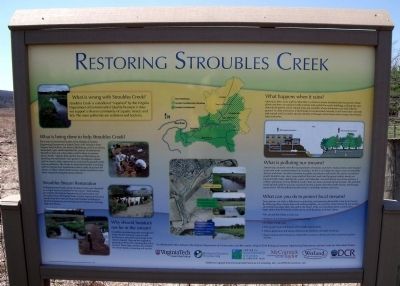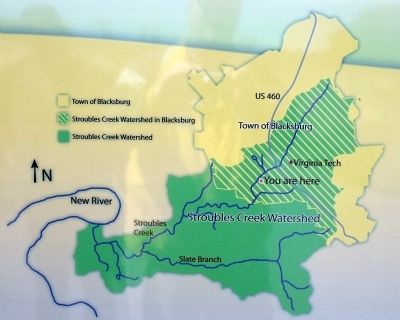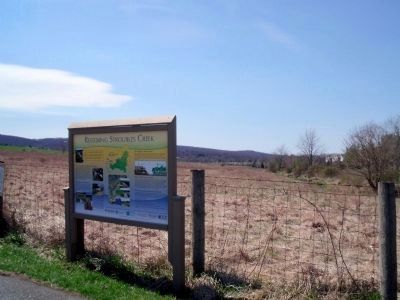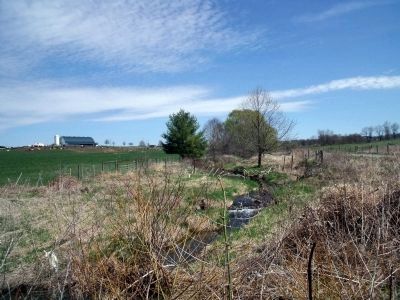Blacksburg in Montgomery County, Virginia — The American South (Mid-Atlantic)
Restoring Stroubles Creek
What is wrong with Stroubles Creek?
Stroubles Creek is considered “impaired” by the Virginia Department of Environmental Quality because it does not support a diverse community of aquatic insects and fish. The main pollutants are sediment and bacteria.
What is being done to help Stroubles Creek?
The Center for Watershed Studies in the Biological Systems Engineering Department at Virginia Tech, with assistance from Virginia Tech Facilities, the Town of Blacksburg, and local citizens, developed a plan which identified the sources of sediment to Stroubles Creek and actions that could be taken to improve stream health. Virginia Tech and the Town of Blacksburg are installing new stormwater “rain gardens” throughout campus and town to allow stormwater to soak into the ground and to remove pollutants. The Center for Watershed Studies is working with the Virginia Tech Foundation to fence cattle away from the stream, to reduce stream bank erosion, and to reestablish native forest vegetation along the stream channel. Stroubles Stream Restoration
Collapsing stream banks along Stroubles Creek were identified as a major source of sediment to the stream. With funding provided by the Virginia Department of Conservation and Recreation from the Virginia Water Quality Improvement Fund, faculty from the Center for Watershed Studies in the Biological Systems Engineering are investigating techniques for restoring degraded streams.
Why should livestock not be in the stream?
In addition to defecating into and adjacent to the stream, livestock, such as cattle and horses, cause physical damage to the stream channel. They eat vegetation growing on the banks, exposing the soil to erosion. These large animals also trample the stream banks, increasing soil erosion.
What happens when it rains?
Most rain, sleet, snow and hail that falls in a forest is slowly absorbed into the ground. When plants and trees are replaced with concrete and asphalt for roads, buildings, parking lots and other development, fewer natural resources are available where stormwater can soak into the ground. In cities and towns, if stormwater is not absorbed naturally, it will travel over concrete and asphalt until it reaches streams directly or through storm drains which empty into streams, lakes and rivers.
What is polluting our streams?
Historically, factories were the main polluters of streams and rivers. National laws were enacted to prevent water contamination from factories, so this is no longer the major cause of unhealthy streams and rivers. So what continues to pollute our streams and rivers? The answer is polluted runoff. Runoff is rain, sleet, snow and hail that can’t soak into the ground where forests are replaced with roads, parking lots, yards, and sidewalks. As runoff travels over these surfaces, it collects pollutants such as fertilizer, trash, motor oil, loose soil and animal manure. This polluted runoff quickly finds its way into our local streams and the New River both directly and though storm drains. All this polluted runoff results in unhealthy streams and rivers.
What can you do to protect local streams?
Every person can make a difference in protecting and improving the health of our local streams. By following these simple steps and working together, we can have clean streams for our families and children to enjoy both now and in the future. Only rain should go down a storm drain. Storm drains lead to streams, so be sure to avoid dumping anything in them.
• Fix oil and fluid leaks on your car.
• Dispose of used motor oil at recycling centers.
• Put litter in trash cans.
• Pick up pet waste and dispose of it in trash cans or toilets.
• Follow application and storage directions for fertilizers and other chemicals.
• Keep livestock out of streams or restrict their access to a limited area that is protected against erosion.
A collaborative effort between the Virginia Department of Conservation and Recreation, Virginia Tech Biological Systems Engineering Department and the Center for Watershed Studies
Additional support from Environmental Services & Consulting, LLC, and RPM Ecosystems, LLC.
Erected by Virginia Tech, Virginia Department of Conservation & Recreation, McCormick Taylor.
Topics. This historical marker is listed in these topic lists: Education • Environment • Waterways & Vessels.
Location. 37° 12.816′ N, 80° 26.526′ W. Marker is in Blacksburg, Virginia, in Montgomery County. Marker can be reached from Stroubles Creek Road south of Foxridge Lane. Marker is located on a footpath along Stroubles Creek. Touch for map. Marker is in this post office area: Blacksburg VA 24061, United States of America. Touch for directions.
Other nearby markers. At least 8 other markers are within walking distance of this marker. Smithfield Plantation (approx. 0.6 miles away); 1820 Slave Cabin (approx. 0.7 miles away); Slaves' Garden (approx. 0.7 miles away); Site Of The Law Offices Of Wm. Ballard Preston (approx. 0.7 miles away); Revolutionary War Patriots (approx. 0.7 miles away); Liberty and Justice for All (approx. 0.7 miles away); William Ballard Preston (approx. 0.7 miles away); Smithfield Blacksmith Shop (approx. 0.7 miles away). Touch for a list and map of all markers in Blacksburg.
Also see . . . Stroubles Creek Site. National Register of Historic Places (Submitted on April 5, 2011.)
Credits. This page was last revised on July 16, 2023. It was originally submitted on April 5, 2011, by Bernard Fisher of Richmond, Virginia. This page has been viewed 1,234 times since then and 43 times this year. Photos: 1, 2, 3, 4. submitted on April 5, 2011, by Bernard Fisher of Richmond, Virginia.



